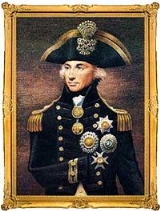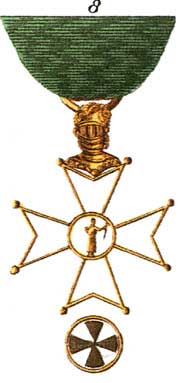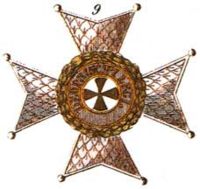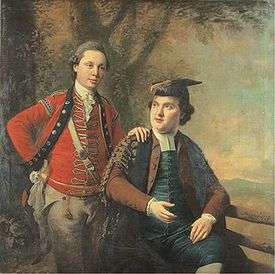
Order of St. Joachim
Encyclopedia




Chivalric order
Chivalric orders are societies and fellowships of knights that have been created by European monarchs in imitation of the military orders of the Crusades...
, although other historians consider it a "self-styled
Self-styled orders
Pseudo-chivalric orders or self-styled orders are organizations which falsely claim to be chivalric orders. Most self-styled orders arose in or after the mid-eighteenth century and many have been created in the present day, though most are short-lived and endure no more than a few decades.A...
" Order
Order (decoration)
An order or order of merit is a visible honour, awarded by a government, dynastic house or international organization to an individual, usually in recognition of distinguished service to a nation or to humanity. The distinction between orders and decorations is somewhat vague, except that most...
of Chivalry. Its most famous member was Admiral Horatio Nelson.
18th century
The "Equestrian, Secular and Chapterial Order of Saint Joachim" was established in 1755 by H.S,H. Prince Christian Franz von Saxen-Coburg-Saalfeld, son of reigning Duke Franz Josias. Prince Christian Franz was installed as its first Grand Master on June 20, 1756, a position he held until 1773.The Order had fourteen founding members who were nobles and military leaders of the Holy Roman Empire, the:
- Duke of Württemberg-Oels;
- Prince Piccolomini;
- Count von Clary und Aldringen;
- Baron von Eib;
- Ritter Fachner von Trauenstein;
- Keck von Schwarzbach;
- Count von Kollowrat-Krakowsky;
- Baron von Milchling;
- Baron Moser von Filseck;
- Count von Nostitz;
- Baron Reichlin von Meldegg;
- Wiedersperger von Wiedersperg; and the
- Baron von Zobel von Giebelstadt.
Having seen the consequences of ongoing religious wars in Europe, the Order's founders dedicated themselves to "worship the Supreme Being, show tolerance towards all religions, loyalty towards their princes, support the needs of their military, the poor, widows and orphans." [Perrot: 1821]. The Order was uniquely composed of both Protestant and Catholic nobles and leaders at a time when religion violently divided Europe and the German states within the Holy Roman Empire, and other knightly orders allied themselves exclusively with one faith or the other.
When the Order was founded in 1755, it was originally with the name "The Knights of the Order of Jonathan, Defenders of the Honour of Divine Providence". In 1767 the reference to Jonathan was removed from the name. Finally, in 1785 a further change was made, and the Order's constitution was revised by the General Chapter to rename it "The Equestrian, Secular and Chapterial Order of Saint Joachim".
Albert Pike
Albert Pike
Albert Pike was an attorney, Confederate officer, writer, and Freemason. Pike is the only Confederate military officer or figure to be honored with an outdoor statue in Washington, D.C...
, prominent American Mason and American Civil War general, erroneously identified the Order of Saint Joachim with Illuminati-related Enlightenment societies. In his 1883 work, "A Historical Inquiry In Regard To The Grand Constitutions Of 1786", he stated that the disbanded Illuminati continued on through the various branches of the Rosicrucian Order, including the later versions of the Gold Rosicrucians, namely, the Order of Perfect Initiates of Asia, or the Asiatic Brethren, and the various Orders of Light, specifically mentioning "The Order of Saint Joachim (St. Jonathan)". Records show that a few Illuminati were members of the early Order of Saint Joachim, specifically Count von Kollowrat-Krakowsky, as well as Freemasons and Rosicrucians. The Order of Saint Joachim had direct connection to the Gülden und Rosenkreuzer (Gold Rosicrucians), founded in 1777, which also had Illuminati and Masonic roots. The Gold Rosicrucians was Hermetic in character, drawing heavily on Eastern and Islamic mysticism. The Gold Rosicrucians was headed by Johann Karl Baron von Ecker und Eckhoffen, who in 1787 was Chancellor of The Order of Saint Joachim. Baron von Ecker und Eckhoffen is named as a member of several other mystic societies, including the Christian Masonry of Bohemia in 1756, and the Asiatic Brethren.
The Order of Saint Joachim was recognized in the late 18th and early 19th centuries by several contemporary sovereigns and states. Leopold II, King of Hungary and Bohemia (later Holy Roman Emperor) formally acknowledged and sanctioned the wearing of the insignia of the Order on May 23, 1790 with a document of Royal Concession. He appointed the Comte Christian von Leiningen, a knight of The Order of Saint Joachim and relative of the Grand Master, to be Chamberlain of the Imperial Palace.
On 27 April, 1791 King Friedrich Wilhelm II of Prussia issued a similar Royal Grant recognizing the legitimacy of the Order and permitting the wearing of the insignia of The Order of Saint Joachim on Prussian officers' military uniforms.
19th century

Napoleon's brother-in-law, Joachim Murat (March 25, 1767 – October 13, 1815), a Marshal of France, usurped the grand mastership of the Order of Saint Joachim in 1806 when was made the Grand Duke of the newly created "Duchy of Berg and Cleves". During his term as Grand Duke of Berg and Cleves (March 15, 1806 to August 1, 1808 when he left to become King of Naples) Joachim Murat declared himself the Grand Master of The Order of Saint Joachim, and expanded the Order to include members of the French Legion of Honor. His authority was never recognized by the rest of the Order in exile.
Something unique and troublesome to many conventional commentators on Orders of knighthood is that The Order of Saint Joachim did not owe its existence to a royal or noble house, or "fons honorium". Its founder and first Grand Master, Prince Christian Franz von Saxen-Coburg-Saalfeld, was the son of a sovereign duke, but never himself a ruler. The next three Grand Masters were sovereign rulers (Duke de Monfort followed by successive counts of Leinigen), and would technically qualify as a "fons". Instead of being a hereditary position, the grand mastership was elected by its members. Writing in 1843, G.L. De Rochement and J. Bischoff ("Ridderorden": Amsterdam, p. 27) observed that The Order of Saint Joachim "does not owe its origins to any crowned head, even so it is recognized both on the European mainland and in Great Britain as an Order of knighthood." Nonetheless, The Order of Saint Joachim was regarded throughout its history as a curiosity among orders by the established orders of knighthood.
A modern writer on Orders of Knighthood, Guy Stair Sainty
Guy Stair Sainty
Guy Stair Sainty, KC*SG is an art dealer and author on royal genealogy and heraldry.-Life and education:Guy Stair Sainty was born on 7 December 1950, the eldest son of Christopher Lawrence Sainty and his second wife Virginia Cade Stair. His father was Chief Engineer and Director of Carrier...
, numbers it among the "self-styled" orders but credits it as a charitable institution. http://www.chivalricorders.org/orders/self-styled/slfstlod.htm He erroneously doubts Nelson's membership in the order and wrongly identified Nelson as a Grand Master of the Order. The post-nominals of a Knight of the Order of Saint Joachim ("K.J.") were recognized in "Debrett's Baronetage of England", and were similarly published in the 1832 "A Key to Both Houses of Parliament"
In 1802, Levett Hanson
Levett Hanson
‘Sir’ Levett Hanson , was an English author.Hanson was born 31 December 1754, at Melton, Yorkshire, was the only son of Robert Hanson of Normanton, Yorkshire, by his wife Elizabeth, daughter of Edward Isaack Jackson of Bury St. Edmunds. His father was the son of Benjamin Hanson and Elizabeth,...
, an English writer and courtier, and Vice-Chancellor of the Order, published An Accurate Historical Account of all the Orders of Knighthood at present existing in Europe, which Hanson dedicated to Admiral Nelson. The work cast the Order of Saint Joachim as equal to any existing chivalric order. Hanson was a childhood friend to Horatio Nelson during their schooling at Paston Grammar School in Paston, Norfolk
Paston, Norfolk
Paston is a village and civil parish in the English county of Norfolk. The village is north-east of North Walsham and south-east of Cromer. It is north-east of the city of Norwich. The village sits astride the coast road between Mundesley and Bacton. The nearest railway station is at North...
, and arranged to have Nelson made Knight Grand Commander of the Order, giving the Order instant cachet.
Hanson had served as Chamberlain
Chamberlain (office)
A chamberlain is an officer in charge of managing a household. In many countries there are ceremonial posts associated with the household of the sovereign....
to the Duke of Modena, as well as at other European royal courts. Hanson was well-connected. HIs godfather was William Wilberforce, a wealthy merchant who was twice mayor of Hull
Kingston upon Hull
Kingston upon Hull , usually referred to as Hull, is a city and unitary authority area in the ceremonial county of the East Riding of Yorkshire, England. It stands on the River Hull at its junction with the Humber estuary, 25 miles inland from the North Sea. Hull has a resident population of...
and grandfather of the reformer
William Wilberforce
William Wilberforce was a British politician, a philanthropist and a leader of the movement to abolish the slave trade. A native of Kingston upon Hull, Yorkshire, he began his political career in 1780, eventually becoming the independent Member of Parliament for Yorkshire...
. Hanson's brother-in-law was Sir Thomas Gery Cullum, 7th Bart.
Thomas Gery Cullum
Sir Thomas Gery Cullum, 7th Baronet was a medical doctor educated at London Charterhouse and Trinity College, Cambridge, and who later practiced surgery at Bury St. Edmunds, Suffolk, where he served as an alderman and DL for Suffolk...
, surgeon, botanist, antiquarian and Bath King of Arms for nearly 30 years. Intrigued at an early age by all things chivalric, Hanson spent his peripatetic life shuttling between European royal courts. His Yorkshire ancestors having been active in the Knights Hospitaller
Knights Hospitaller
The Sovereign Military Hospitaller Order of Saint John of Jerusalem of Rhodes and of Malta , also known as the Sovereign Military Order of Malta , Order of Malta or Knights of Malta, is a Roman Catholic lay religious order, traditionally of military, chivalrous, noble nature. It is the world's...
s, Hanson was intrigued by the domains in Europe where chivalry and knighthood still held sway. By enticing his friend Nelson to join the Order, Hanson landed the biggest 'catch' in the world of knighthood.
But even the Admiral Nelson 'get' couldn't erase the whiff of impropriety about Hanson's St Joachim affiliation. Critics noted that the Order seemed to be domiciled wherever Hanson found himself, and that 'Knighthoods' were available to anyone with sufficient funds. "It was long understood," wrote one contemporary observer, "that moyennant a certain not inconsiderable deposit at a banking house at Pall-mall, the distinction was at the service of any one who might have a fancy for it; and that letters-missive were soon forthcoming from Sir Levett, containing due notification of election by the 'equestrian, secular and chapteral Order,' at its last sitting at Bamberg, Hamburgh, Lubeck or wherever that personage happened, at the time, to be domiciliated."
20th and 21st centuries
The Order historically has a small membership - 14 at its founding and only 75 at the time Nelson was made a member. It was reorganized in 1929 and 1948 and was led by Helmut von Bräundle-Falkensee (1950 - 2007) from 1988 until his death on 14 October 2007. He was an Austrian who was also Secretary General of the Austrian Albert Schweitzer Society. After his death, the Canadian Chevalier Stephen Lautens (b. 1959), who was serving as the Order's Coadjutor Grand Master, was elected the new Grand Master. http://www.stjoachimorder.org/grandmaster.htm. It has its Chapterhouse in England and additional Commanderies in the United States, Canada and Austria. It is registered as a charity in the U.K. (UK registered charity No. 1047873) and supports the homeless, ex-servicemen, hospitals and children's charities. It is organized as a federal not-for-profit corporation in Canada. In Austria it operates a small volunteer service for the ambulatory care and transportation of the sick and needy.A recent exhibition displaying the heraldry of Admiral Nelson at the College of Arms
College of Arms
The College of Arms, or Heralds’ College, is an office regulating heraldry and granting new armorial bearings for England, Wales and Northern Ireland...
in 2005 featured a replica of Nelson's uniform with its honorary blazons. Among the orders of merit worn by Nelson, which included the Order of the Bath
Order of the Bath
The Most Honourable Order of the Bath is a British order of chivalry founded by George I on 18 May 1725. The name derives from the elaborate mediæval ceremony for creating a knight, which involved bathing as one of its elements. The knights so created were known as Knights of the Bath...
(whose heraldic expert was Hanson's brother-in-law Sir Thomas Cullum), was the Order of St Joachim. The star, said the College of Arms in its newsletter, was "the bogus Order of St. Joachim created and hawked around the Courts of Europe by 'Sir' Levett Hanson." In a subsequent newsletter several months later, the editors backed off their earlier condemnation, issuing a partial retraction:
"The Order of St. Joachim referred to in the last issue," said the College-of-Arms, "was not (as there stated) created by Levett Hanson but dated back to an order founded in 1755 by a group of mostly German princes."
The breast star of The Order of Saint Joachim Nelson was wearing at Trafalgar is attached to the famous "Trafalgar Coat" which he was wearing when mortally wounded at the battle of Trafalgar in 1805, and is on permanent display at the National Maritime Museum in Greenwich, England..

